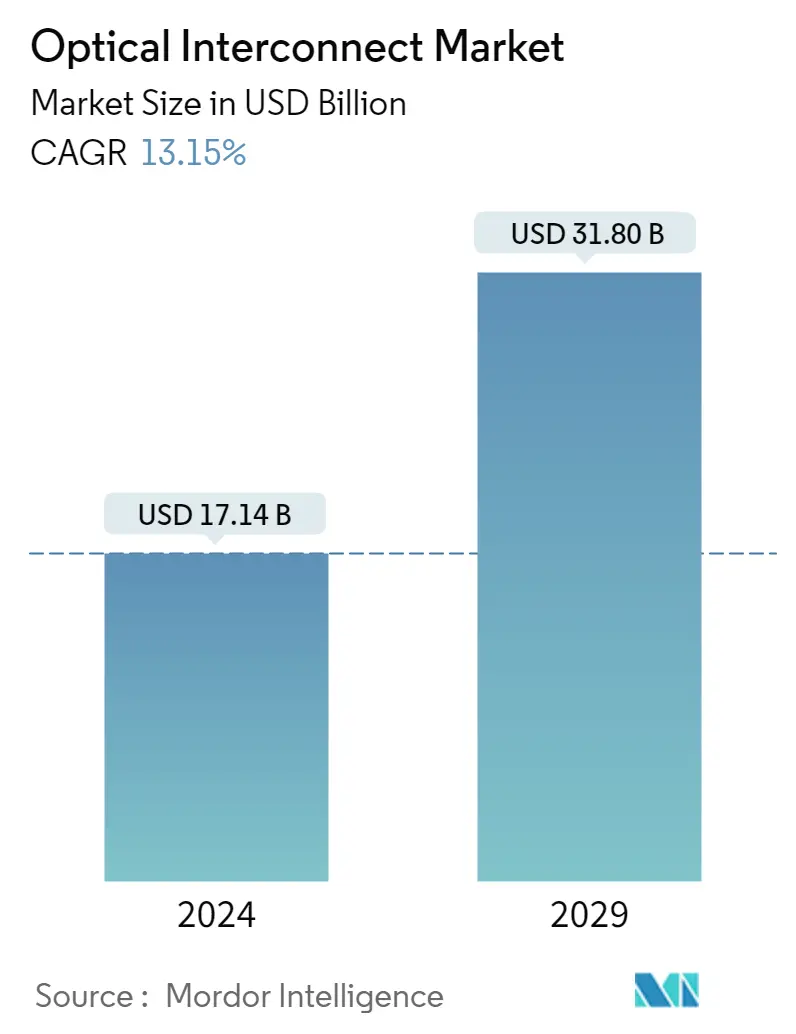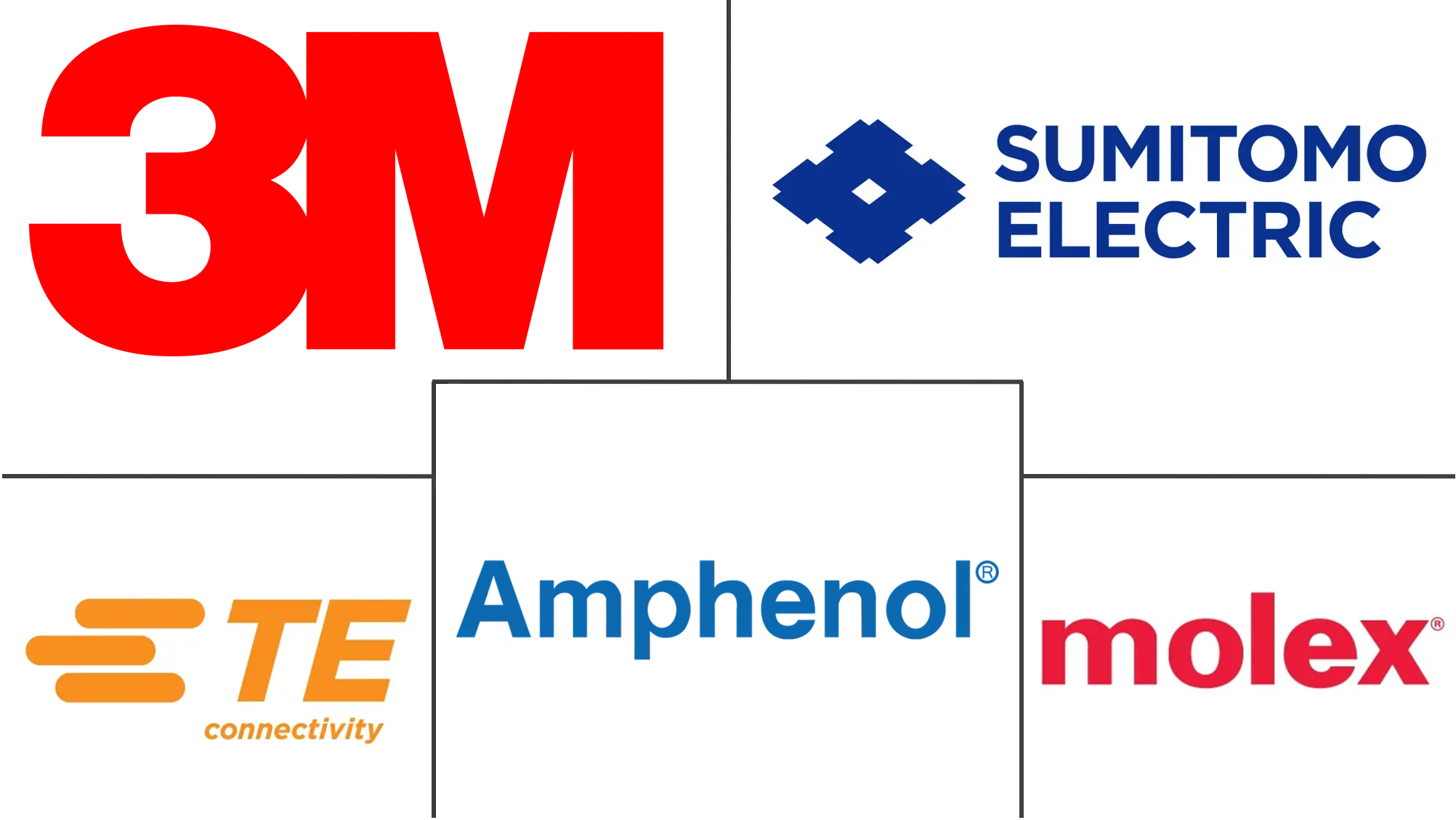Market Size of Optical Interconnect Industry

| Study Period | 2019 - 2029 |
| Market Size (2024) | USD 17.14 Billion |
| Market Size (2029) | USD 31.80 Billion |
| CAGR (2024 - 2029) | 13.15 % |
| Fastest Growing Market | Asia Pacific |
| Largest Market | Asia Pacific |
Major Players
*Disclaimer: Major Players sorted in no particular order |
Optical Interconnect Market Analysis
The Optical Interconnect Market size is estimated at USD 17.14 billion in 2024, and is expected to reach USD 31.80 billion by 2029, growing at a CAGR of 13.15% during the forecast period (2024-2029).
Due to the adverse effects of COVID 19 across industries, players such as 3M are currently manufacturing medical products to assist various stakeholders globally, to combat Covid-19. 3M has doubled production of N95 respirators to 1.1 billion per year at its global manufacturing facilities, including in the U.S., Asia, and Europe. This has led to reduced manufacturing for optical interconnect cables.
However, as the ability to work from home has become an absolute necessity, market players such as Nexcom (Taiwan) plans to help telecom providers and data centers across the world to virtualize and expand capacity. For meeting current network demands for faster speeds, the NC 220FMS3 module provides a PCIe3.0 x16 interface and two QSFP28 ports, each supporting 100Gb/s Ethernet connectivity. The module provides high-speed connectivity without any packet loss. The 100 G optical transceivers (providing 100Gb/s ethernet), their form factor type, and standard are developed according to the cost and power consumption, which are regarded as the main drive in the development for interconnect market, which potentially drives the demand of optical interconnect.
- Moreover, directly modulated VCSEL arrays, parallel fiber ribbons, along with detector arrays, are highly being applied to optical backplane capacity issues. In the future, additional higher functionality is highly expected as an emerging trend for optical interconnects, which includes features such as cross-connect switches and data packet routing in the optical domain.
- The increasing demand for communication bandwidth is expected to drive the market. Due to the emergence of a large number of new services in different types of communications and their value-added entities, the demand for bandwidth has gone up more than ever before. Optical interconnect drive it possible in providing more bandwidth and bring great advantage to computing performance, compared to electrical interconnects.
- With optics, over the next decade, it is believed that the energy-requiring for cross-chip communication would approach less than 0.5 pJ b1 and to 0.1 pJ b1 for communication, such as off-chip communication technology. By utilizing the ability to move data affordably, both the power consumption and the total cost for such future multicore processor systems are expected to be reduced with improving bandwidth.
- Since the beginning of 2020, vendors, like Ciena, Infinera, Huawei, and Nokia, have been pushing the limits of modern optics. Huawei CloudFabric EVN Layer 2 DCI solution provides highly permits scalable, efficient layer 2 interconnection that allows expansion of up to 32 data centers across IP WANs. Like Huawei, competing vendors, like Ciena or Infinera, are also working on their 800G-capable coherent solutions, which may power next-generation optical DCI platforms.
- By the second quarter of 2020, millions of people switched to work from home, and video consumption (which amounts to 60% of the global data traffic) was at an all-time high. Critical services were being impacted, and Wi-Fi access points were facing congestion; FWA witnessed limitations, and interconnect points were burdened.
- These scenarios also surge the cloud computing activities, along with significantly increasing investments from the industrial and enterprises segment. All these factors made a massive boom in the data center market along with technologies incorporated to expand the capabilities of data centers. Such trends are expected to further stimulate the growth of the market studied.
Optical Interconnect Industry Segmentation
The optical interconnect refers to any system of transmitting signals from one part of an integrated circuit to another using light and are highly being used in applications, such as telecommunication and data communication, and further providing connectivity solutions in the end-user industries, such as military and aerospace and automotive.
| Type | |
| Optical Transceivers | |
| Active Optical Cables (AOCs) | |
| Embedded Optical Modules (EOMs) |
| Application | |
| Telecommunication | |
| Data Communication |
| Geography | ||||||
| ||||||
| ||||||
| ||||||
| Latin America | ||||||
| Middle East and Africa |
Optical Interconnect Market Size Summary
The optical interconnect market is poised for significant growth, driven by the increasing demand for high-speed data transmission and the need for efficient communication bandwidth. As industries adapt to the surge in remote work and cloud computing, the demand for optical interconnects has escalated, offering advantages such as high throughput, low latency, and reduced power consumption compared to traditional electrical interconnects. Key players in the market, including Ciena, Infinera, Huawei, and Nokia, are pushing the boundaries of optical technology to meet the growing needs of data centers and telecommunications. Innovations such as Huawei's CloudFabric EVN Layer 2 DCI solution and Ayar Labs' monolithic in-package optical I/O solution are set to enhance interconnect bandwidth density and energy efficiency, supporting the expansion of data center capabilities.
The market landscape is characterized by a fragmented nature with several key and prominent vendors focusing on innovation, strategic collaborations, and awareness campaigns to stabilize and grow their market presence. Companies like 3M, Sumitomo Electric Industries, and Corning Inc. are actively investing in expanding their optical interconnect capabilities, with Corning's fiber optic cable plant expansion being a notable example. The North American region, with its rapid internet penetration and significant cloud traffic, is expected to be a major growth driver, supported by advancements in 5G technology and the increasing adoption of optical interconnects in data centers. As the market evolves, the integration of optically switched interconnects and the development of high-bandwidth, low-latency solutions are anticipated to play a crucial role in meeting the future demands of data communication networks.
Optical Interconnect Market Size - Table of Contents
-
1. MARKET DYNAMICS
-
1.1 Market Overview
-
1.2 Market Drivers
-
1.2.1 Increasing Demand for Communication Bandwidth Owing to Demand for Cloud Computing, AI, and HPC
-
1.2.2 Increasing Investment in Data Centers Interconnect and Fiber Optic Communication
-
-
1.3 Market Restraints
-
1.3.1 Slow Commercialization of Optical Interconnection Related Technologies
-
-
1.4 Industry Value Chain Analysis
-
1.5 Industry Attractiveness - Porter's Five Forces Analysis
-
1.5.1 Threat of New Entrants
-
1.5.2 Bargaining Power of Buyers/Consumers
-
1.5.3 Bargaining Power of Suppliers
-
1.5.4 Threat of Substitute Products
-
1.5.5 Intensity of Competitive Rivalry
-
-
1.6 Assessment of Impact of Covid-19 on the Market
-
-
2. MARKET SEGMENTATION
-
2.1 Type
-
2.1.1 Optical Transceivers
-
2.1.2 Active Optical Cables (AOCs)
-
2.1.3 Embedded Optical Modules (EOMs)
-
-
2.2 Application
-
2.2.1 Telecommunication
-
2.2.2 Data Communication
-
-
2.3 Geography
-
2.3.1 North America
-
2.3.1.1 United States
-
2.3.1.2 Canada
-
-
2.3.2 Europe
-
2.3.2.1 Germany
-
2.3.2.2 United Kingdom
-
2.3.2.3 France
-
2.3.2.4 Rest of Europe
-
-
2.3.3 Asia Pacific
-
2.3.3.1 India
-
2.3.3.2 China
-
2.3.3.3 Japan
-
2.3.3.4 Rest of Asia Pacific
-
-
2.3.4 Latin America
-
2.3.5 Middle East and Africa
-
-
Optical Interconnect Market Size FAQs
How big is the Optical Interconnect Market?
The Optical Interconnect Market size is expected to reach USD 17.14 billion in 2024 and grow at a CAGR of 13.15% to reach USD 31.80 billion by 2029.
What is the current Optical Interconnect Market size?
In 2024, the Optical Interconnect Market size is expected to reach USD 17.14 billion.

